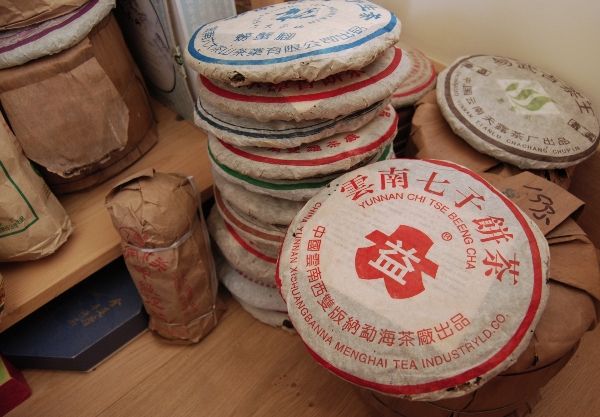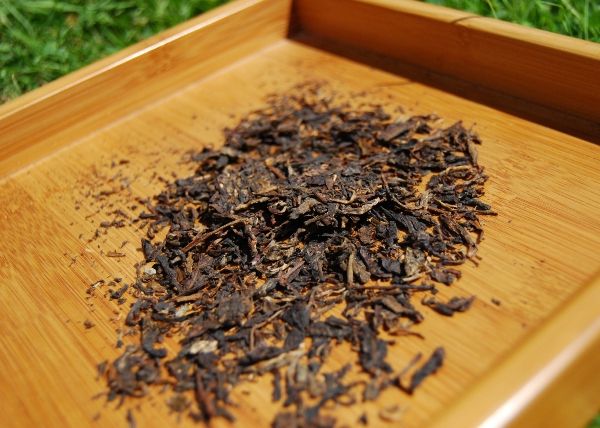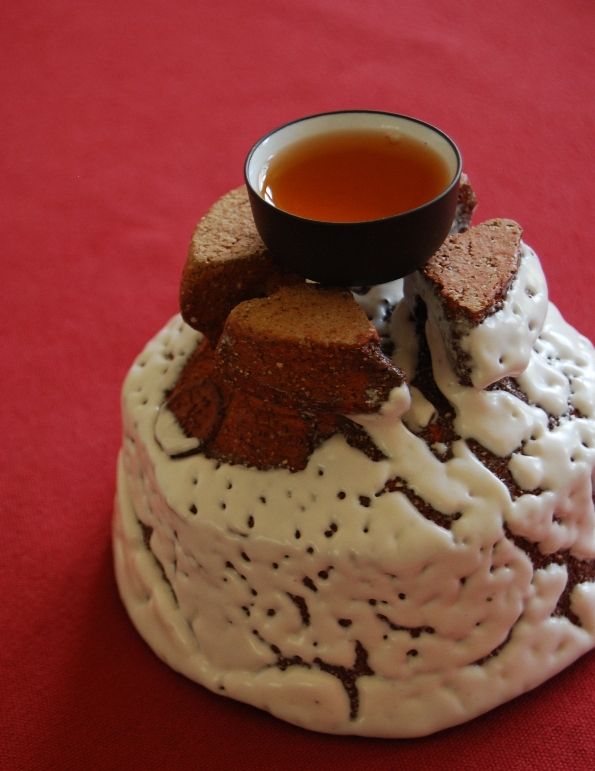I have a hypothesis. Like all hypotheses, this one gives an explanation of the observed facts, and makes predictions that may be tested. It may or may not be correct, but I present it to you for your consideration.
Is it as easy as 7-5-3-2?
I contend that some of the "solid, reliable recipes" have changed. I contend that "7532", while surely fluctuating from year to year according to the minute changes in leaf character and blending that one would expect with the passing years, is significantly different to how it used to be in 2004. I contend that this difference is more significant than small changes due to yearly harvests. Let's examine the facts.
Loosely compressed, with large leaves,
the older cakes feel a lot less "factory"-produced than more recent examples
the older cakes feel a lot less "factory"-produced than more recent examples
Crack open a modern-day 7532 and you'll be confronted with the usual Dayi experience: densely compressed, brisk Menghai aroma, familiar straw-and-mushroom character. Dip into an older production of the same recipe (here, 2004), and it's a very different affair. The leaves are much larger, on the whole - which may not come out in the photograph above. The change in compression is obvious: the older cakes have a larger diameter and a larger thickness than the newer cakes, and are more loosely compressed. Modern Dayi cake are relatively tiny, compared to most 375g bingcha.
The older varieties also seem much more punchy - truly hair-raising. As they have aged, they have retained this power. There is more in the older cakes, evident from their youth, and continuing as they age. It's fascinating.
Chunkiness be thy name
Is there any mileage in my hypothesis? Perhaps, perhaps not. While I continue to buy small amounts of modern Dayi, it must be said that the older 7532 and 7542 attract my attention a little more.
If we tentatively accept for now that there may have been some shift in production, when did it occur? I've had 2004 and 2005 cakes that were of this "older" style, and so offer you a date of 2006. I don't remember trying a 2006 cake of '32 or '42. The 2007 cakes were certainly of the more modern super-compressed, smaller-diameter variety, with a more rough-and-ready quality of leaf.
Either way, this 2004 cake is a sterling example of good Dayi. It is heavy, long, and sweet. This particular cake is right at the age I enjoy the most: the turn between yellow youth and woody adolescence. It contains both power and woodiness. Happily, it marches on forever - my more recent 7532s tend to fade out earlier.
As with all hypotheses, I invite you to confirm or refute it at your pleasure. Be sure to disseminate your findings!




Not to disagree with you exactly, but cakes do tend to expand with age somewhat.
ReplyDeleteI volunteer to test this theory properly and with full rigour. I need a full cake of 7542 and 7532 from every year starting from 1990.
ReplyDeleteSo readers, send me your tea.
I wish to make it clear I will obviously gain no pleasure from this experiment. It is purely a mission in the name of truth.
Dear Lew,
ReplyDeleteProgress can only be made through the debate of other points of view - dissent and argument are part of the scientific method! So, I encourage disagreement.
While it is certainly true that cakes loosen over time, I have found that my modern Dayi cakes are not loosening to the same degree as my older cakes. Have you noticed a similar effect?
Matters of compression aside, the other differences in characteristics between older and newer Dayi standard recipes are perhaps more striking.
Dear Drumhum,
It is a brave soul indeed that shoulders such a burden for the benefit of the many. :)
Toodlepip,
Hobbes